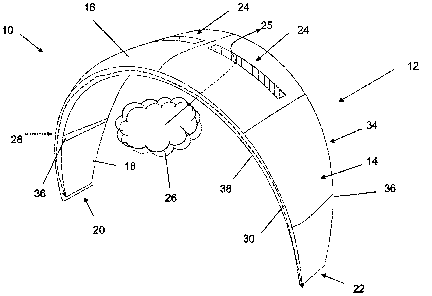Some of the information on this Web page has been provided by external sources. The Government of Canada is not responsible for the accuracy, reliability or currency of the information supplied by external sources. Users wishing to rely upon this information should consult directly with the source of the information. Content provided by external sources is not subject to official languages, privacy and accessibility requirements.
Any discrepancies in the text and image of the Claims and Abstract are due to differing posting times. Text of the Claims and Abstract are posted:
| (12) Patent Application: | (11) CA 2638666 |
|---|---|
| (54) English Title: | INFLATABLE KITE WITH VENTS |
| (54) French Title: | CERF-VOLANT GONFLABLE AVEC PRISES D'AIR |
| Status: | Withdrawn |
| (51) International Patent Classification (IPC): |
|
|---|---|
| (72) Inventors : |
|
| (73) Owners : |
|
| (71) Applicants : |
|
| (74) Agent: | J. GORDON THOMSONTHOMSON, J. GORDON |
| (74) Associate agent: | |
| (45) Issued: | |
| (22) Filed Date: | 2008-08-12 |
| (41) Open to Public Inspection: | 2009-02-13 |
| Availability of licence: | N/A |
| Dedicated to the Public: | N/A |
| (25) Language of filing: | English |
| Patent Cooperation Treaty (PCT): | No |
|---|
| (30) Application Priority Data: | ||||||
|---|---|---|---|---|---|---|
|
An inflatable kite uses an inflatable tubular member as a leading
edge. The wing is a membrane attached to the front of the leading
edge to form a high camber for high lift. Vents in the wing fabric
have flaps on them to form nozzles which, when wind is blowing
over the kite, cause high pressure air under the kite to exhaust to
the top surface of the kite and extend conditions of near laminar
flow towards the trailing edge. This increases kite stability and
improves stall characteristics.
Note: Claims are shown in the official language in which they were submitted.
Note: Descriptions are shown in the official language in which they were submitted.

2024-08-01:As part of the Next Generation Patents (NGP) transition, the Canadian Patents Database (CPD) now contains a more detailed Event History, which replicates the Event Log of our new back-office solution.
Please note that "Inactive:" events refers to events no longer in use in our new back-office solution.
For a clearer understanding of the status of the application/patent presented on this page, the site Disclaimer , as well as the definitions for Patent , Event History , Maintenance Fee and Payment History should be consulted.
| Description | Date |
|---|---|
| Inactive: First IPC assigned | 2022-07-01 |
| Inactive: IPC assigned | 2022-07-01 |
| Inactive: IPC expired | 2020-01-01 |
| Inactive: IPC expired | 2020-01-01 |
| Inactive: Office letter | 2013-03-26 |
| Inactive: Withdraw application | 2013-03-18 |
| Inactive: Withdraw application | 2013-03-18 |
| Letter Sent | 2009-06-02 |
| Inactive: Single transfer | 2009-04-03 |
| Application Published (Open to Public Inspection) | 2009-02-13 |
| Inactive: Cover page published | 2009-02-12 |
| Inactive: First IPC assigned | 2009-01-02 |
| Inactive: IPC assigned | 2009-01-02 |
| Inactive: IPC assigned | 2009-01-02 |
| Inactive: Office letter | 2008-10-07 |
| Application Received - Regular National | 2008-10-02 |
| Inactive: Filing certificate - No RFE (English) | 2008-10-02 |
| Small Entity Declaration Determined Compliant | 2008-08-12 |
There is no abandonment history.
The last payment was received on 2012-07-12
Note : If the full payment has not been received on or before the date indicated, a further fee may be required which may be one of the following
Patent fees are adjusted on the 1st of January every year. The amounts above are the current amounts if received by December 31 of the current year.
Please refer to the CIPO
Patent Fees
web page to see all current fee amounts.
| Fee Type | Anniversary Year | Due Date | Paid Date |
|---|---|---|---|
| Application fee - small | 2008-08-12 | ||
| Registration of a document | 2009-04-03 | ||
| MF (application, 2nd anniv.) - small | 02 | 2010-08-12 | 2010-07-09 |
| MF (application, 3rd anniv.) - small | 03 | 2011-08-12 | 2011-07-04 |
| MF (application, 4th anniv.) - small | 04 | 2012-08-13 | 2012-07-12 |
Note: Records showing the ownership history in alphabetical order.
| Current Owners on Record |
|---|
| OCEAN RODEO SPORTS INC. |
| Past Owners on Record |
|---|
| ROSS D. HARRINGTON |